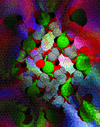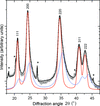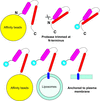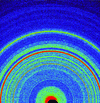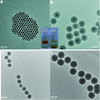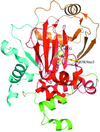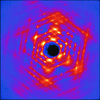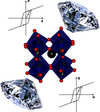issue contents
November 2014 issue

editorial
CHEMISTRY | CRYSTENG
Today, there is very little doubt that chemistry owes as much to crystallography as crystallography does to chemistry. This mutual synergy defines modern chemical crystallography.
research letters
CHEMISTRY | CRYSTENG
Rietveld/MEM analysis applied to synchrotron powder X-ray diffraction data of dehydrated CHA zeolites with catalytically active Cu2+ reveals Cu2+ in both the six- and eight-membered rings in the CHA framework, providing the first complete structural model that accounts for all Cu2+. Density functional theory calculations are used to corroborate the experimental structure and to discuss the Cu2+ coordination in terms of the Al distribution in the framework.
BIOLOGY | MEDICINE
A method is presented for the automatic building of nucleotide chains into electron density which is fast enough to be used in interactive model-building software. Likely nucleotides lying in the vicinity of the current view are located and then grown into connected chains in a fraction of a second. When this development is combined with existing tools, assisted manual model building is as simple as or simpler than for proteins.
research papers
PHYSICS | FELS
An expectation maximization algorithm is implemented to resolve the indexing ambiguity which arises when merging data from many crystals in protein crystallography, especially in cases where partial reflections are recorded in serial femtosecond crystallography (SFX) at XFELs.
PHYSICS | FELS
The time evolution of the electron density and the resulting time dependence of the X-ray polarizability of a crystal irradiated by highly intense XFEL femtosecond pulses is investigated theoretically. Rate equations for bound electrons and the Boltzmann equation for the unbound electron gas are used in calculations.
NEUTRON | SYNCHROTRON
Melting of the semicrystalline structure of native tapioca starch granules is correlated to solution viscosity for elucidating gelatinization and gelation processes.
BIOLOGY | MEDICINE
A neutron crystallographic study of perdeuterated transthyretin reveals important aspects of the structure relating to its stability and its propensity to form fibrils, as well as evidence of a single water molecule that affects the symmetry of the two binding pockets.
MATERIALS | COMPUTATION
It has been revealed that in cylindrical nano-confinement, the hydrogen-bonding direction of nylon-12 crystals in the rod could self-assemble to be parallel to the long axis of the rod. The dominant growth direction and hydrogen-bonding direction of the γ-form crystal in the long axis of the rod has been revealed by TEM–SAED and WAXD.
MATERIALS | COMPUTATION
The capability of X-ray diffraction for the microstructure investigations of metastable systems is illustrated on supersaturated and partially decomposed thin films of titanium aluminium nitrides with high aluminium content. The anisotropy of the elastic constants and their role in these investigations is discussed.
feature articles
CHEMISTRY | CRYSTENG
Contributions of experimental and selected theoretical charge-density research to medicinal chemistry are reviewed; combining experimental methods from high-resolution small-molecule and macromolecular crystallography with theory proves to be fruitful.
BIOLOGY | MEDICINE
Pressure can play a key role in probing the structure and dynamics of membrane assemblies, and is also critical to the biology and adaptation of deep-sea organisms. This article presents an overview of the effect of pressure on the structure of membranes and recent developments in high-pressure instrumentation.
NEUTRON | SYNCHROTRON
Possibilities in auxiliary technique combinations with small- and wide-angle X ray scattering are described, as well as more complicated sample environments used in X-ray and neutron scattering.
BIOLOGY | MEDICINE
The X-ray structures of viruses and viral proteins currently available are providing high-resolution snapshots of viral molecular machineries, expanding our vision of the virus world and giving crucial information on potential targets for future antiviral therapies.
BIOLOGY | MEDICINE
Mammalian Munc18 proteins are essential for membrane fusion and human health. Here, we review the literature describing structural and in vitro data, and identify a possible explanation for the conflicting functional roles that have been reported.
MATERIALS | COMPUTATION
The X-ray diffraction/X-ray fluorescence instrument CheMin on the Curiosity rover is a shoebox-sized device using transmission geometry and an energy-discriminating CCD detector. The instrument has returned the first X-ray diffraction data for soil and drilled samples from Mars outcrops, revealing a suite of primary basaltic minerals, amorphous components and varied hydrous alteration products including phyllosilicates.
BIOLOGY | MEDICINE
A review of recent and ongoing development and results within the field of biological solution small-angle X-ray scattering (BioSAXS), with a focus on the increasing complexity of biological samples, data collection and data evaluation strategies.
MATERIALS | COMPUTATION
This feature article reviews the control and understanding of nanoparticle shape from their crystallography and growth. Particular emphasis is placed on systems relevant for plasmonics and catalysis.
BIOLOGY | MEDICINE
The structure and function of dioxygenases in histone demethylation and DNA/RNA dimethylation are discussed.
MATERIALS | COMPUTATION
This review discusses the state of the field of single-crystal diffuse scattering (SCDS), including detectors, data collection and the modelling techniques. High quality, three-dimensional volumes of SCDS data can now be collected at synchrotron light sources, allowing increasingly detailed and quantitative analyses to be undertaken.
CHEMISTRY | CRYSTENG
Recent advances in the crystallography of metal–organic frameworks (MOFs) are reviewed, including crystal growth, structural elucidation, in-situ and non-ambient crystallography.
MATERIALS | COMPUTATION
This work presents a discussion of the possibilities offered by X-ray absorption spectroscopy (XAS) to study the local structure of nanomaterials. The current state of the art for the interpretation of extended X-ray absorption fine structure (EXAFS), including an advanced approach based on the use of classical molecular dynamics, is described and exemplified in the case of NiO nanoparticles. In addition, the limits and possibilities of X-ray absorption near-edge spectroscopy (XANES) in determining several effects associated with the nanocrystalline nature of materials are also discussed in connection with the development of ZnO-based dilute magnetic semiconductors and iron oxide nanoparticles.
MATERIALS | COMPUTATION
The effect of high pressure on the synthesis, properties and atomic structure of multiferroic materials with perovskite or perovskite-related structures is reviewed.
NEUTRON | SYNCHROTRON
Are synchrotrons needed for innovation in industry? What can scientists at large-scale facilities offer for R&D in industry? Is the comfort of life profiting from research?



 journal menu
journal menu





 access
access



